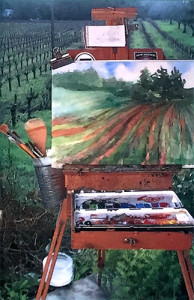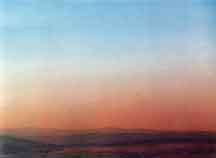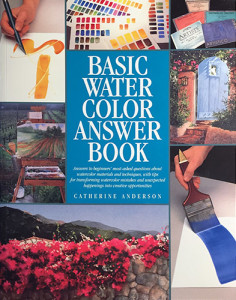Basic Watercolor Answer Book
“In the beginner’s mind there are many possibilities, but in the expert’s mind there are few.”
~Shunryu Suzuki
Basic Watercolor Answer Book
North Light Book Club Editor’s Pick of the Month
“Basic Watercolor Answer Book will teach beginners where to start. You’ll learn about all your product choices (brushes, paints, papers…) and how to best apply them. For intermediates, you’ll learn tricks and techniques to complement and enhance your current painting groove. And advanced painters will find refreshing reminders about the basics, plus advice about what’s new on the market.”
Introduction
I wanted to open my book with a story that has a powerful lesson as essential to understand and practice as the questions and answers in this book – if not more essential. You can read this book and a hundred other books and learn a great deal about watercolor. If you keep the knowledge in your head and never apply it because you are afraid to make a mistake, take a risk, take action and confront your inner critics, you will never paint.
The Story Goes Like This…
 Mary, a beginner in my evening watercolor class, was a poet. She was exceptionally knowledgeable about the arts and an extremely interesting person whom I enjoyed having in class. She painted exactly what she wanted and rarely used a photograph for reference. I often wondered what went through her mind while she was painting these fascinating paintings; they looked kind of like folk art.
Mary, a beginner in my evening watercolor class, was a poet. She was exceptionally knowledgeable about the arts and an extremely interesting person whom I enjoyed having in class. She painted exactly what she wanted and rarely used a photograph for reference. I often wondered what went through her mind while she was painting these fascinating paintings; they looked kind of like folk art.
Then one day I won an award in the American Watercolor Society’s annual exhibit. A friend and I decided to fly to New York City to attend the awards dinner to receive my award. It thrilled us to see the show, and we were ecstatic about being in New York. We took in as many of the galleries and art museums we possibly could, soaking in all the art. It was a stimulating and rejuvenating trip for both of us.
In my first evening class after our return, Mary handed me a small painting. It was a beautiful landscape of what looked like a little pond, and she said to me with great pride, “Look what I did while you were gone!” It was like nothing she had ever painted before. I praised her on what a wonderful job she did and told her how proud I was of her. I thought the painting was a done deal—finished. Obviously, Mary did not think so. “I wanted to ask your opinion on something first before I did it. I was thinking about putting a whale in the middle of the pond. What do you think?”
Speechless, it took me a moment before I could respond. “God, help me come up with something,” I prayed. I thought of all the art I had seen in the New York museums—old mattresses hanging from the ceiling and wrapped in bungee cords, a black hearse covered with tar and all sorts of objects stuck to it at the Whitney Museum of American Art, the Metropolitan Museum of Art, the Guggenheim, the Museum of Modern Art.
God knows how much time I took to respond, but the question that came to me was, “What is art all about anyway?” I realized, at that moment, that there really are no rules. Critiquing Mary’s work would have stopped the creative process of expressing what she wanted to express. Who am I to tell anyone what or how she should express anything? It was her painting, and I handed it back to her. “Mary, put the whale in!”
There are no real rules or formulas (however, I do help my students who want rules, so don’t worry). I didn’t care if Mary wanted to put Big Bird in the middle of the pond. She had the guts and confidence to express herself. She put the whale in. Mary had no rules.
I have told that story to my other classes and workshops—and it has stuck. I have heard them shouting across the room, “Oh, put the whale in!” And some of them have painted whale paintings.
The Lesson Is…
Are you having a problem taking a risk because you are afraid of making a mistake? Do you hear that voice saying to you, “I wonder what would happen if?” Go ahead…
PUT THE WHALE IN!
More about the book…
Which paints and brushes should I buy? What colors do I mix to get that color? How can I make my paintings look brighter? What’s a “Funny Brush”? A glaze? “Mud”? Oops!… and how do I fix mistakes?
 In the Basic Watercolor Answer Book, award winning artist Catherine Anderson answers 100+ of the most asked questions about painting in watercolor- from how much paint to squeeze out on your palette to how to make the most of watercolor’s inevitable “surprises.” In quick reference, Q & A format, Catherine offers help on:
In the Basic Watercolor Answer Book, award winning artist Catherine Anderson answers 100+ of the most asked questions about painting in watercolor- from how much paint to squeeze out on your palette to how to make the most of watercolor’s inevitable “surprises.” In quick reference, Q & A format, Catherine offers help on:
- paper and painting surfaces. What’s good paper to practice on, without spending a fortune? How can I prevent my paper from buckling? What does “acid free” mean?
- brushes and their care. How do I know what help me in the painting? How do I “use the white on my paper?” How can I create soft edges to give my paintings that soft watercolor look?
- tonal values. How can I make a simple object look dimensional? What is a value sketch and how can it help me?
- painting outdoors, on location and from life. What kind of palette should I use for outdoor painting? How can I make my clouds look softer? My water look like water?
Chapter 7 answers the “doozie” of all water color questions: Is this a mistake or a creative opportunity? Have faith and see how you can transform problem paintings into great successes (and valuable lessons) with creative changes in color, composition, cropping and more.
Drab Desert to Stunning Seascape! Here is an example of how what you may perceive as a mistake is actually a creative opportunity.

Wishing You Were Here Again
“Do not be afraid when you have a choice to make. Trust yourself enough to let you learn from mistakes.” – Jerry Mills, 1996
In addition to loads of practical information (much of which you won’t find anywhere else), this book also includes lots of step-by-step demonstrations, gorgeous paintings, clever ideas and words of encouragement to keep your spirits high. Whether you’ve been painting for ten minutes or ten years, you’re bound to have a slew of questions. These answers can make your attempts more successful, more confident and a whole lot more fun!
ORDER NOW!
Basic Watercolor Answer Book by Catherine Anderson is available, signed by the artist/author for $74.95
You can also find Basic Watercolor Answer Book by Catherine Anderson on amazon.com.
Author’s Comments
My love affair with the medium of watercolor has grown deeper over the years. Today, I paint with my whole heart and soul. Techniques have become second nature, so I am able to go deeper into a force that drives my work. I able to take more and greater risks. This is why I wrote my book…to help all sorts of artists that share this same dream.
It is a basic how-to-do watercolor book for the beginner, yes, but my goal was much higher than that. I take the beginner beyond the basics to what I feel are just as important (if not more) as the basics they must learn. I teach them ‘mind techniques’. First I go step-by-step so that when they are finished reading it, they will be able to put a painting together. It’s clear, right to the point. I’ll be using it as my textbook.
My book is based on the column I’ve been writing for the quarterly publication Watercolor Magic, called “Water Rescue,” which recently was voted the #1 column and ‘most interesting’ by the readers. I also write for the Artist’s Magazine.
Woven throughout the book are the ‘mind techniques’, which I feel are the most important ingredients missing in many books. So much is left out…mostly the things you need to know, and the beginner is left hanging. I feel there are so many technique books out there, you could drown in them. My goal was not only to teach the basics, but to talk about these ‘mind techniques.’ I wanted the book to really offer something. It was time for me to share these with aspiring artists so that they too, could fulfill their dream. You could sign up for a dozen workshops a year and learn technique after technique, different palettes from different teachers, etc., but if you don’t learn to work with your mind, you’ll never touch your brush to paper when you return home…ever.
I speak from my own experiences, fears, mistakes, and how I turned them into creative opportunities! One of the things I did was I kept a sheet of paper next to me to keep track of my hours each day…like a time clock to see where my time went. That taught me discipline. I committed to a minimum of 6 hours a day of painting. I made mistake after mistake and learned from each one of them. Mistakes are gifts and this is how you learn. I worked through many, many fears. The book is about risking , making that mistake at any cost! Learning that you may just get the results you were searching for! It’s about working through our fears and seeing the joy it brings us when we do.
I had a dream and I never lost sight of it. I thank God, my Grandfather, my parents, all the mistakes I made, the fears I pushed through and the risks I took to make this beautiful book happen.
Remember there are no rules! The book is inspirational and encouraging. It belongs in every library, watercolor class, with anyone who loves watercolor, and well, anyone who wants to learn about taking risks in life. So whenever you hear that little voice inside you saying to you (in anything you want to do), I wonder what would happen if???” Go ahead – listen to your intuition and take that risk!!!
I hope that you have as much fun reading the book as I did writing it! I also hope you learn a few things too…I know I have …Someone said, “So? You wrote your own self-help book, heh?” You know? I think I did. I know I did.


